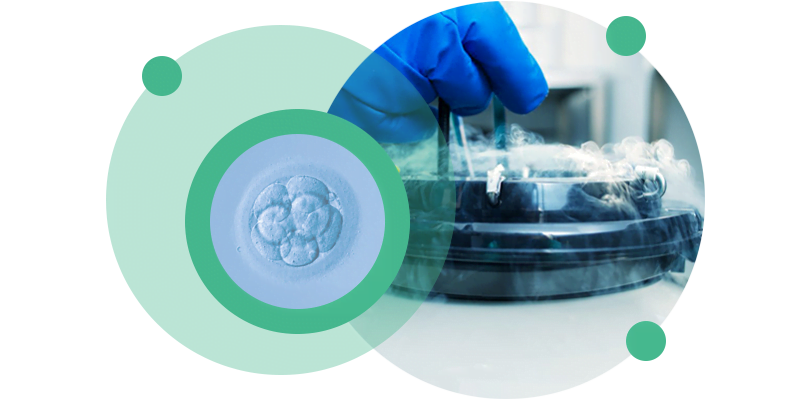Cryopreserved Embryo Transfer (TEC)
Cryopreserved Embryo Transfer is the process by which embryos that have been cryopreserved in a previous IVF/ICSI cycle are thawed and transferred into the patient’s uterus.

About Cryopreserved Embryo Transfer
Cryopreserved embryo transfer is the process by which embryos that have been cryopreserved in a previous IVF/ICSI cycle are thawed and transferred into the patient’s uterus. In addition to thawing and transferring the embryos, this treatment involves preparing the endometrium to receive the embryos.
The endometrium is the layer of the uterus in which the embryos will implant and goes through several phases throughout the woman’s menstrual cycle, so it is essential that there is synchronization between the embryo and the endometrium for implantation to occur.
An IVF/ICSI cycle often involves obtaining more good quality embryos than can be transferred into the patient’s uterus in that treatment cycle. These excess embryos can be cryopreserved for use in a future cycle.
In other situations, it is not possible or is not advisable to transfer embryos in the IVF/ICSI treatment cycle in which they were created, either due to the risk of Ovarian Hyperstimulation Syndrome, or in cases where the embryos have undergone Pre-implantation Genetic Diagnosis and it is necessary to wait for the genetic results.
There are also embryos that are cryopreserved but whose beneficiaries, after the necessary legal time has elapsed and do not wish to use them, donate them to other beneficiaries (Embryo Donation).
In all these cases, a treatment cycle is carried out to transfer the cryopreserved embryos, which does not involve new ovarian stimulation, but requires preparation of the endometrium in order to increase its receptivity and increase the probability of embryo implantation and, therefore, pregnancy.
The ECT cycle involves preparing the endometrium to receive the embryos that will be transferred. Therefore, when you are ready to start ECT, either after a previous unsuccessful treatment or for a new pregnancy, you should make an appointment with your doctor.
Medical consultation
An assessment is made of the best endometrial preparation protocol to follow. The number of embryos to be transferred is also discussed and the Informed Consent for Cryopreserved Embryo Transfer is signed by both members of the couple in the case of heterosexual couples or female couples.
Endometrial preparation
There are several endometrial preparation protocols, making it possible to carry out the treatment in a natural cycle or medicated cycle.
- Natural cycle – a woman’s natural menstrual cycle is used, without the use of medication. Ultrasound scans are necessary to monitor the evolution of the thickness and ultrasound pattern of the endometrium, as well as the development of the ovarian follicle that is developing during that cycle. You may be advised to take ovulation tests or you may be given medication to trigger ovulation. In this second part of the endometrial preparation, you may be advised to take oral and/or vaginal medication. Embryo transfer will take place approximately one week after ovulation.
- Hormone replacement cycle – in this case, medication is used to replace natural hormones. In the first part of the endometrial preparation, oral estrogens are used and monitoring ultrasounds are performed to assess the thickness and ultrasound pattern of the endometrium. Once the optimal thickness is reached, progesterone is started vaginally and/or orally to complete the endometrial preparation. Embryo transfer will take place approximately one week after starting to take progesterone.
Thawing of embryos
After scheduling the TEC date, the laboratory will thaw the embryos so that they correspond in terms of day of development to the stage of the endometrium. At CETI, with rare exceptions, the embryos are cryopreserved in the blastocyst stage, which corresponds to the 5th or 6th day of embryonic development. In this case, the embryos are thawed hours before transfer. After thawing, the embryos are kept in culture in incubators with a suitable atmosphere and in culture media that promote embryonic development.
Embryo transfer
Embryo transfer is a quick procedure that does not require analgesia/sedation, in which one or more embryos are introduced into the uterine cavity using a catheter specifically designed for this purpose.
bHCG analysis
12 days after embryo transfer, a blood test is performed to detect the hormone bHCG, the pregnancy hormone.
Embryo transfer is a minimally invasive procedure, but after which it is recommended to rest for two days, abstain from sex for 5 days and avoid intense physical exertion until the pregnancy test is performed (12 days after transfer).






Frequently Asked Questions
During the preparation of the endometrium for an ECT cycle, you may have to undergo, on average, two to three monitoring ultrasound scans.
The success rate of ECT, both nationally and internationally, is over 40%. Since the success of any medically assisted reproduction treatment depends on a variety of factors, you should discuss your particular case with your doctor.
According to current Portuguese Law, embryos can remain cryopreserved for a period of 3 years, renewable for an additional period of 3 years.
If you do not wish to transfer the embryos that you have cryopreserved, you may consent to their donation to other beneficiaries of Medically Assisted Reproduction treatments or to their donation to scientific research projects. If you do not consent to any of these destinations, the embryos will be thawed and discarded.
Although embryo vitrification is a well-established technique in Assisted Reproduction laboratories, it is not possible to guarantee that the embryo will survive the freezing and thawing procedures. However, the embryo survival rate is quite high, and situations in which an embryo does not survive the procedure are rare. It is important that these techniques are performed by experienced professionals.
You can consult CETI’s price list here.
